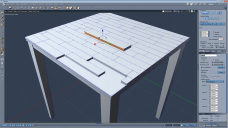Question/Issue about UV, Vertical, horizontal textures.
 Scorpio87
Posts: 82
Scorpio87
Posts: 82
I have an issue and question regarding applying textures on objects to minimize or avoid distorting. I have never had this issue before until recently, however all my new documents/projects are having the issues when creating a dedicated texture, the texture is distorted when applied to vertical(side) of a surface.
I have provided some images to help give a clear picture. I am not sure what I did to change my way of skinning an object, however I cannot seem to fix it. Any help would be greatly appreciated.
(I have also provided an image in the texture room of 3 planes rotated on each axis , primitive cube, and a plane that was extruded.
Thank you,
Joanght


Untitled.png
1920 x 1080 - 375K


Side Texture distort.png
1920 x 1080 - 808K


Close up BG 01.png
1000 x 1300 - 2M


Render Table Chair.png
3000 x 3900 - 6M


Step3.png
1000 x 1300 - 1M
Post edited by Scorpio87 on


Comments
some modelling actions destroy UV, extruding might maintain the UV of the existing polygons but the extruded bit lies between those polygons so naturally it would stretch as you extruded it.
the best solution is to create new surfaces under global for each plank side and flat map them along the axis needed to place as a rectangle following the grain of the texture.
Thank you for the advice. (Your method worked really well. Counter intuitive to how I am used to model :P ) .
I used what you suggested and created all new independent surfaces with their own texture (without extruding). I did experiment with copying the existing surface, deleting the original and pasting in the surface deattached from the extruded polygon and it still distorted. I am curious why extrude surfaces are such a way even after you cut them from the original object , wouldnt they delete the original UV wrap?
Heres an image wood slat for the table surface (tongue and grove) using Wendy's method.
It won't 'delete' the mapping, but extruding something that has already been UV mapped can certainly mess with the existing map.
Just to be more clear:
Even adding new shader domains will not change the mapping - it will simply create a new shader zone - useful for the abilty to use an entirely different shader, but also to give it special attention (viewing) in the UV Unwrap tab in the model room. For example: I can make a new shading domain and apply an invisible shader to make a hole. Further, I can make a new shading domain so that I can select to view only that domain while UV Mapping. If I want to map this domain separately from the rest of the mesh, I often need to "Detach" the selected comain from the rest of the mesh so it doesn't just stretch the edges as I work with the mapping. By Detaching, I can move the selected domain anywhere on the map I want to, resize, rotate, scale, etc.,
That being said, I'll often set vertical surfaces on one axis to have at least one separate domain of its own. Then in UV Mapping, I set to only see one of those domains, detach from the rest, and then project planar mapping on the given axis. Then I resize and shape the selection to the dimensions that make sense for what I'm doing. I'm sure that it's a lot easier to do that it is to follow what I'm saying... argh!!!
Thank you so much for the advice! And don't worry! I totally can follow what youre saying. (image is after deattaching UV). (Fast render low light details)
Good job!